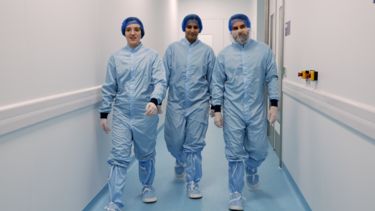Sheffield is taking a leading role in pioneering new treatments for genetic diseases
The GTIMC (Gene Therapy Innovation and Manufacturing Centre) is part of the University's vision to create a fast-track process for innovation in gene therapy.

The aim of this pioneering hub is to see more life-changing medicines entering clinical trials. This incredible facility, that our donor community helped to realise, is helping to rewrite the future for people living with life-altering genetic diseases.
A closer look at how new therapies for genetic diseases are manufactured
Gene therapy is emerging as a potential treatment for a number of genetic diseases, through the use of ‘viral vectors’.
By removing the harmful properties of a virus, a ‘therapeutic gene’ can be introduced into a patient’s cells. This treatment can replace or switch off a faulty gene that’s damaging tissue in the body which can alleviate or even reverse the impact of genetic diseases.
Discover how these ‘viral vectors’ are manufactured by journeying through the GTIMC’s different labs.
-
The Research and Development Lab
-
The need for sterile and entirely clean spaces is just one of the reasons that gene therapy research is so expensive and complex. The Research and Development Lab allows researchers to carry out the same viral vector manufacturing process as in the clean rooms but at a smaller scale. They can use this lab to work up the process in a smaller, cheaper and more flexible way, before they transfer that process into the clean room environment, for larger scale manufacturing.
Creating viable viral vectors to carry new therapies to patients is incredibly difficult and expensive. The more work that can be done inside this lab to understand that process the cheaper and more efficient manufacturing new treatments will become. This will then reduce the cost of the end product, making the treatments for patients more affordable.
This lab is home to the bioreactor that our inspiring community of supporters came together to fund. The bioreactor is used to grow the cell cultures needed to produce the viral vectors. Within the bioreactor is a culture vessel used to contain the cells and a control unit used to maintain the environment the cells are growing in. The cells are grown in suspension in the culture vessels which use a stirring or rocking motion to keep the cells from aggregating or settling on the bottom of the vessel.
-
The Manufacturing Labs
-
The data and the information learnt in the Research and Development Lab is then used in the Manufacturing Lab to upscale the manufacture of the viral vectors.
The manufacturing process breaks down into two broad areas - upstream processing where mammalian cells are grown in incubators and bioreactors as tiny factories to pump out the viral vectors. And the downstream process where chromatography and tangential flow filtration (TFF) are used to purify the vectors and switch them into buffers that are safe to be injected into the patient.
-
The Clean Spaces
-
Clean Rooms are a vital component in gene therapy research. Contamination must be controlled in order to consistently produce a sterile medicine.
The biggest source of contamination are the researchers themselves. Before entering the clean rooms street clothes must be removed and multiple layers of scrubs and protective clothing must be worn.
The clean rooms inside the GTIMC have different grades depending on the level of cleanliness required within them. Their Grade A Clean Room houses the isolator and must have the highest level of cleanliness with zero viable and non-viable particles inside the room.
Isolators provide an enclosed environment which can be sterilised to ensure harmful microbial contaminants will not compromise the final product. It is vital that the final vector product is sterile so that it can be safely administered to patients. Therefore packaging of products is conducted within an isolator.
-
The Quality Control Lab
-
Finally, the quality control lab is where the new treatments are tested to check that they are fit for purpose and safe for patients.
For example, the potency of a drug must be as described so that those administering the treatment to patients as part of a clinical trial can do so effectively and consistently.
In pharmaceutical manufacturing patient safety is critical so if the treatments don’t meet the standards that the quality control lab set then the batch fails and the process starts all over again.
A look inside the newly constructed Gene Therapy Innovation and Manufacturing Centre (GTIMC), to see the essential equipment that your donations have funded.





